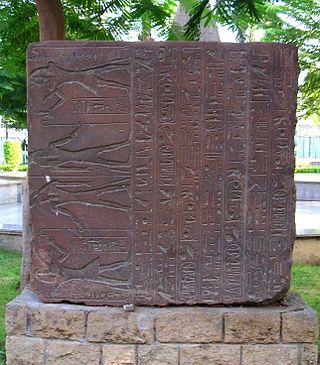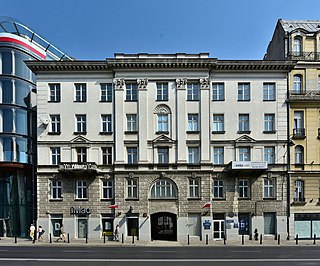
Kazimierz Józef Marian Michałowski was a Polish archaeologist and Egyptologist, art historian, member of the Polish Academy of Sciences, professor ordinarius of the University of Warsaw as well as the founder of the Polish Centre of Mediterranean Archaeology. He coined the term "Nubiology" to refer to the study of ancient Nubia.

Athribis was an ancient city in Lower Egypt. It is located in present-day Tell Atrib, just northeast of Benha on the hill of Kom Sidi Yusuf. The town lies around 40 km north of Cairo, on the eastern bank of the Damietta branch of the Nile. It was mainly occupied during the Ptolemaic, Roman, and Byzantine eras.

Faras was a major city in Lower Nubia. The site of the city, on the border between modern Egypt and Sudan at Wadi Halfa Salient, was flooded by Lake Nasser in the 1960s and is now permanently underwater. Before this flooding, extensive archaeological work was conducted by a Polish archaeological team led by professor Kazimierz Michałowski.
Tell Arbid is an ancient Near East archaeological site in the Khabur River Basin region of Al-Hasakah Governorate, Syria, about 50 kilometers north northeast of modern Al-Hasakah. It is located 45 kilometers south of Tell Mozan, the site of ancient Urkesh and about 15 kilometers from the site of Chagar Bazar. The Halafian site of Tell Arbid Abyad is a short distance away.

Tell Qaramel is a tell, or archaeological mound, located in the north of present-day Syria, 25 km north of Aleppo. The settlement has several circular stone towers dating back to the period between 10650-9650 BCE, making them the oldest such structures in the world.

Nemrik 9 is an early Neolithic archeological site in the Dohuk Governorate in the north of modern-day Iraq.

The Polish Centre of Mediterranean Archaeology University of Warsaw operates as an independent research institute of the University of Warsaw under the present name since 1990. It is dedicated to organizing, implementing and coordinating archaeological research, both excavations and study projects, as well as conservation, reconstruction and restoration projects, in northeastern Africa, the Near East and Cyprus. Projects include sites covering a broad chronological spectrum from the dawn of civilization through all the historic periods of the ancient Mediterranean civilizations to Late Antiquity and early Islam. Tasks beside fieldwork include comprehensive documentation of finds, archives management and publication of the results in keeping with international research standards. The PCMA manages the Research Centre in Cairo and Polish Archaeological Unit in Khartoum.
Kemune is an archaeological site discovered during a low water level in the reservoir of the Mosul Dam in the Nineveh Governorate, part of the Kurdistan region of Iraq in 2013. The Mitanni era city was destroyed by an earthquake around 1350 BC.
Bahra 1 is an archaeological site in the Subiya region on the coast of Kuwait Bay (Kuwait) associated with the Ubaid culture. It is one of the earliest Ubaid culture settlements in the Persian Gulf region, about 5500–4900 BC.
Bijân Island is an island in the middle Euphrates, in the historical land of Suhum. It belongs to a group of islands on which archaeological sites have been recorded.
Subiya or al-Subiyah is a region in northern Kuwait on the north coast of Kuwait Bay (Kuwait), consisting of several micro-regions: Bahra, H3, Nahdain, Radha, Muhaita, Mughaira, Dubaij, and Ras al-Subiyah. The area features archaeological sites with tumuli graves, settlements, campsites, wells, and shell middens. Most of the tumuli date to the Early and Middle Bronze Age. Subiya is the location of the Silk City project, the project's first phase was launched in May 2019.
Tell Amarna is an archaeological site near the village Amarnah in northern Syria, on the west bank of the Euphrates.
Tell Djassa is an archaeological site in Syria, in the Khabur River basin, in the area of the Khabur Triangle in Upper Mesopotamia.
Tell Abu Hafur is an archaeological site in Syria, in the Khabur River basin, in the area of the Khabur Triangle in Upper Mesopotamia.
Tell Saadiya is a tell, or archaeological settlement mound, in Diyala Governorate (Iraq).
Tell Rad Shaqrah was a fortified rural settlement in Syria, in ancient Upper Mesopotamia. It is located on the northern bank of the Khabur River, about 15 kilometers from Hassake (Al-Hasaka).
Tell Raffaan is an archaeological site in Iraq, in ancient Upper Mesopotamia, in the valley of the Tigris River.
Qumayrah Valley – a valley in northern Oman, in the Al-Hajar Mountains in the Ad Dhahirah Governorate. It stretches for about 10 kilometers between the villages of Ayn Bani Sa’dah (al-Ayn), Qumayrah and Bilt.
Piotr Bielinski is a Polish Mediterranean archaeologist, professor of humanities, specializing in the archaeology of the ancient Middle East. His research interests include the art - especially glyptics - and architecture of Mesopotamia, Syro-Palestine, Anatolia, and the Persian Gulf from the Chalcolithic to the Bronze Age. He has led over a dozen Polish archaeological expeditions to the Middle East.
Tell al-Hawa is an ancient Near East archaeological site on the North Jazira Plain of northern Iraq, near the border with modern-day Syria and just west of the Tigris river. It lies 40 kilometers southwest of the site of Tell Hamoukar and about 90 kilometers northwest of modern Mosul. Occupation at the site began in the 5th millennium BC Halaf period and continued, with periods of abandonment, until the Islamic period. Settlement reached a substantial size in the 4th millennium BC Uruk period and the late 3rd millennium BC Akkadian Empire period. A modern village, 26 hectares in size, lies off the east edge of the main mound. Tell al-Hawa was excavated as part of a regional rescue archaeology program resulting from the completion of the Mosul Dam and the subsequent expansion of irrigated agriculture. Beveled rim bowls, diagnostic of the Uruk Culture, were found at the site.





